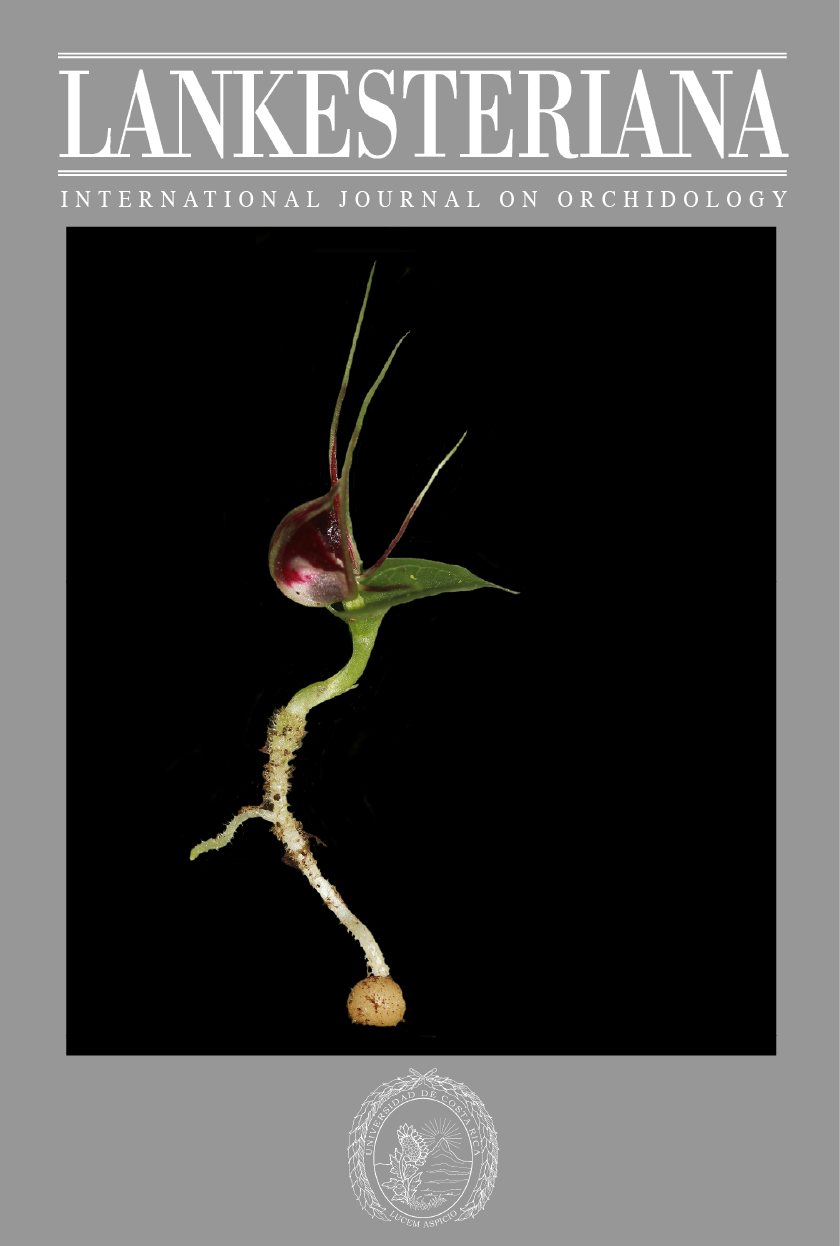<i>Corybas geminigibbus</i>, a new addition to the orchid flora of Sumatra
DOI:
https://doi.org/10.15517/lank.v24i3.60323Keywords:
monocots, montane bogs, taxonomy, West MalesiaAbstract
Corybas is an orchid genus of 154 species distributed from India to South China, the Western Pacific, and New Zealand. Sumatra is home to eight species, five of which are endemic. However, the true diversity is likely underestimated due to limited exploration in some parts of the island. During a recent exploration in the northern Gayo Plateau near the northern tip of the island, a Corybas species was discovered that did not match any previously known species. Further identification through specimen comparison and literature review confirmed that the species is Corybas geminigibbus. It was found growing in montane bogs. This discovery marks the second bioregion in Indonesia where this species has been recorded and the ninth Corybas species on the island. The finding also provides additional evidence of floristic similarities, suggesting past geological connections between northern Sumatra and mainland Asia. A detailed description, discussion, and photographs are provided.
Downloads
References
Beentje, H. (2016). The Kew plant glossary: An illustrated dictionary of plant terms. Second edition. Richmond: Royal Botanic Gardens Kew.
Chantanaorrapint, S. & Chantanaorrapint, A. (2016). Corybas geminigibbus (Orchidaceae), a new species record for Thailand. Thai Forest Bulletin, Botany, 44(1), 11–14.
Comber, J. B. (1990). Orchids of Java. Richmond: Royal Botanic Gardens Kew.
Comber, J. B. (2001). Orchids of Sumatra. Richmond: Royal Botanic Gardens Kew.
Comber, J. B. & Dransfield, J. (1995). Three new Corybas species from Sumatra. Malayan Orchid Review, 29, 70–76.
Davies, N., Drinkell, C. & Utteridge, T. M. A. (2023). The herbarium handbook. Richmond: Royal Botanic Gardens Kew.
De Wilde, W. J. J. O. & Duyfjes, B. E. E. (1994). Brief history of the botanical exploration in the Gunung Leuser Natural Park and vicinity, North Sumatra with itineraries and reports of the exploration tours by Van Steenis (1937) and De Wilde & Duyfjes (1972–1991). Flora Malesiana Bulletin, 11(4), 253–291.
Dransfield, J., Comber, J. B. & Smith, G. (1986). A synopsis of Corybas (Orchidaceae) in West Malesia and Asia. Kew Bulletin, 41(3), 575–613.
JSTOR. (2024). Global Plants on JSTOR. Retrieved from https://plants.jstor.org [Accessed 5 June 2024].
Metusala, D. (2017). Two new species of Paphiopedilum (Orchidaceae: Cypripedioideae) section Barbata from Sumatra, Indonesia. Edinburgh Journal of Botany, 74(2), 169–178.
Middleton, D. J., Armstrong, K., Baba, Y., Balslev, H., Chayamarit, K., Chung, R. C. K., Conn, B. J., Fernando, E. S., Fujikawa, K., Kiew, R., Luu, H. T., Aung, M. M., Newman, M. F., Tagane, S., Tanaka, N., Thomas, D. C., Tran, T. B., Utteridge, T. M. A., van Welzen, P. C., Widyatmoko, D., Yahara, T. & Wong, K. M. (2019). Progress on Southeast Asia’s Flora projects. Gardens’ Bulletin Singapore, 71(2), 267–319. doi: 10.26492/gbs71(2).2019-02
POWO. (2024). Plants of the World Online. Facilitated by the Royal Botanic Gardens, Kew. Retrieved from: http://www.plantsoftheworldonline.org/ [Accessed May 2024].
Seidenfaden, G. & Wood, J. J. (1992). The orchids of Peninsular Malaysia and Singapore. Liechtenstein: Olsen & Olsen.
Truong, V. B., Nguyen, V. C., Ormerod, P., Truong, Q. C., Chu, V. T. & Kumar, P. (2020). The genus Corybas in Vietnam, with two new records. Lankesteriana, 20(1), 49–55.

Published
How to Cite
Issue
Section
License
Copyright (c) 2024 Lankesteriana: International Journal on Orchidology

This work is licensed under a Creative Commons Attribution-NonCommercial-NoDerivatives 3.0 Unported License.
According to the Open Access policy promoted by the University of Costa Rica, all the papers published by Lankesteriana are licensed under the Creative Commons copyright and can be downloaded free of charge. The journal holds copyright and publishing rights under the CC BY-NC-ND 3.0 CR license.
Before the publication of the materials submitted by the author(s) in LANKESTERIANA, the author(s) hereby assign all rights in the article to the Lankester Botanical Garden.




